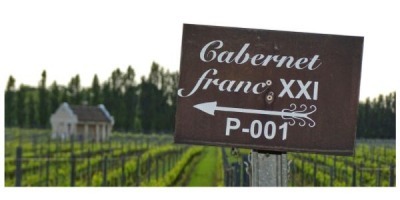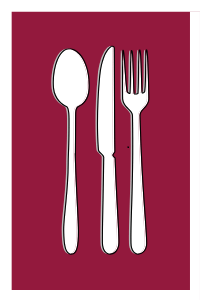No products in the basket.

A guide to the Cabernet Franc grape and where it is grown, the characteristics of Cabernet Franc wine and what it tastes like plus what to eat with Cabernet Franc. Despite being in the 20 most planted grapes in the world, Cabernet Franc is not necessarily one of those grapes that you look for when choosing wine. It tends to keep a low profile – more of a bridesmaid than the bride. But, for years overshadowed particularly by Cabernet Sauvignon, Cabernet Franc is reckoned to be on the upward trend.
Black grape variety Cabernet Franc is a bit of a workhorse, more often seen as a support grape to Cabernet Sauvignon and Merlot and, since it ripens earlier, it is used as an insurance should those grapes not have chance to ripen fully due to poor weather. Having said that, Cabernet Franc needs a lot of sunshine to ripen and lose some of its naturally high acidity, otherwise it can taste rather green and stalky. It is rather like Cabernet Sauvignon but lighter and less tannic.
The reason for the similarity to Cabernet Sauvignon is that Cabernet Franc and Cabernet Sauvignon are in fact related though it was only about 25 years ago that DNA profiling confirmed Cabernet Franc to be a parent to Cabernet Sauvignon (the other being Sauvignon Blanc). A fruity little number in more ways than one, Cabernet Franc has also been discovered to be a parent to Merlot and to Carmenère.
Note Cabernet Franc is also known as Bouchet, Bordo, Breton and Cabernet Frank. Italian wines labelled Cabernet are usually Cabernet Franc.

Many Bordeaux wines have Cabernet Franc as a minority grape in the blend. The notable exception is St Emilion and the other right bank appellation, Castillon Côtes de Bordeaux, where it is given more prominence; in fact, the renowned St Emilion Grand Cru, Château Cheval-Blanc, instead of having Merlot as its majority grape, has c. 60% Cabernet Franc and is considered by some to be the finest wine of the Bordeaux region.
Aside from Bordeaux, Cabernet Franc has long been seen as a varietal in the red wines of Touraine in the Loire Valley, wines such as Chinon and Bourgeuil, and of Saumur also in the Loire. In total France accounts for c. 58% of global Cabernet Franc production. Perhaps surprisingly Brazil is second in terms of volume at 12% with Italy third at 10%; the cooler areas in the north-east, Friuli and Veneto, see most of the plantings in Italy. There are further Cabernet Franc vines in many countries around the world but not in huge volumes, reflecting the fact that the grape is usually added to Bordeaux style blends.
Increasingly however Cabernet Franc is being seen as a varietal wine on its own especially in cooler regions of new world wine-producing countries like the USA, Canada, Argentina and Chile. Yields need to be controlled to ensure that the grape’s fruit rather than herbaceous characteristics dominate; this means that it is not really a grape for the lower end of the price range.
Cabernet Franc shares many characteristics of Cabernet Sauvignon but it is lighter in many ways – lighter in body, tannin, alcohol, colour and acidity – so it makes a good alternative for those who find Cabernet Sauvignon a little over the top. Generally medium bodied Cabernet Franc still has sufficient structure, fruit, acidity and tannins to age well – and age earlier than Cabernet Sauvignon. It is also generally much easier to drink, lighter and softer with a smooth texture. In fact it can be a very elegant wine. The overriding feature however is its beautiful perfume.
Fruit characteristics abound in Cabernet Franc, think berries and cherries – raspberries in particular, strawberries, blueberries, cherries along with plums. Graphite or pencil shaving aromas are also typical. Other common aromas and flavours of Cabernet Franc include green pepper, green olives, violets, sweet tobacco and blackcurrant leaves. Generally the warmer the climate, the rounder and richer the Cabernet Franc wine and the more prominent the fruit aromas and flavours. The herbaceous aromas are more prominent when the grapes used in the wine have not been ripened fully. And this is the one downside to Cabernet Franc.
A note of caution: Cabernet Franc is relatively well suited to the cool climate of the Loire and North East Italy as it ripens early compared to some varieties. At their best these wines can be fresh, fruity, low alcohol wines with a distinct raspberry and pencil shavings aroma profile. But those originating from particularly cool summers can taste rather austere and be especially light in body. Unripe Cabernet Franc can have rather harsh stalky characteristics. So to ensure a softer Cabernet Franc wine with good texture and integrated tannins, be wary of those produced in very cool vintages.

Cabernet Franc’s acidity and body make it a good match for a number of different foods. Its berry and herbaceous characteristics make it a particularly good match for game, lamb, duck and for herby and olive- and tomato-based dishes. Warmer climate Cabernet Franc with its rich plum flavours will go well with most red meats, especially roast beef, with mushrooms, peppers and with many cheeses including brie, camembert, smoked cheeses and even goat’s cheese.
Look first at the intensity of the food and match heavier, more intensely flavoured wines with stronger-flavoured foods and lighter styles with more delicate flavours.
According to the University of Adelaide’s Database of Regional, National & Global Winegrape bearing areas, there was an increase of 7% in the vineyard area dedicated to Cabernet Franc globally between 2000 and 2016. Whilst France and Italy have both reduced their plantings in that period, countries that saw growth include Brazil, the USA, Chile, Argentina, Hungary and Canada where it is even being used for ice wine.
If you are a fan of Cabernet Sauvignon, Merlot or Carmenère, give Cabernet Franc a try. You will be pleasantly surprised by its elegance, complexity and its beautiful perfume. Given the general trend away from higher-alcohol red wines, Cabernet Franc could come into its own at last.
© 2014-2025 Wines with Attitude Ltd | VAT Reg. No. 181 2419 22 | Registered in England 08918466 | Fiveways, 57-59 Hatfield Road, Potters Bar, Herts, EN6 1HS